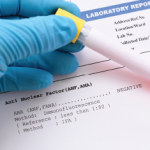 Do patients with rheumatoid arthritis (RA) who also have a positive test for anti-nuclear antibody (ANA) have a different disease course or treatment needs than those who test negative for ANA? A retrospective, population-based, cohort study by Pakinar et al. published in ACR Open Rheumatology in June examined patients with RA who are either ANA positive or ANA negative, highlighting apparent differences in their disease progression, disease course, therapies and characteristics.1
Do patients with rheumatoid arthritis (RA) who also have a positive test for anti-nuclear antibody (ANA) have a different disease course or treatment needs than those who test negative for ANA? A retrospective, population-based, cohort study by Pakinar et al. published in ACR Open Rheumatology in June examined patients with RA who are either ANA positive or ANA negative, highlighting apparent differences in their disease progression, disease course, therapies and characteristics.1
In their introduction, Pakinar et al. discussed past studies that have questioned the role of routine ANA testing in patients with RA, with mixed findings on connections between ANA positivity, treatment and specific RA outcomes. For example, a 2005 observational study found patients with ANA-positive RA who were treated with tumor necrosis factor (TNF) inhibitors were more likely to have certain autoimmune complications, including a drug-induced lupus, than those not treated with TNF inhibitors.2 However, a single cohort study published in 2014 of 454 patients with RA treated with a TNF inhibitor did not show any clear association between ANA positivity and the lupus-like complication. In that 2014 study, some links were made between the development of ANA positivity during treatment and secondary treatment nonresponse.3
The current study was launched to learn more about possible differences between ANA positivity in patients with RA and their disease course and treatment.
The researchers at the Mayo Clinic, Rochester, Minn., examined data collected from residents in surrounding Olmsted County who first fulfilled the 1987 ACR criteria for RA from 2009 to 2014. The data included rheumatoid factor (RF), anti-cyclic citrullinated peptide antibody (anti-CCP) and ANA results collected when the patients first showed signs of joint swelling. The data also contained patients age, sex, smoking status and presence of obesity at the time of RA criteria fulfillment. The researchers accessed medical records from patients treated at multiple healthcare facilities in the county through the Rochester Epidemiology Project. Their results were first presented at ACR Convergence 2020.
“Even in the general population, there have been some observable differences between ANA-positive and ANA-negative individuals. Could there be differences between these groups in RA patients?” asks Sujaytha S. Paknikar, MD, an internal medicine resident at the Mayo Clinic and a study co-author.
When female patients with suspected systemic lupus erythematosus (SLE) or scleroderma first present to a rheumatologist, ANA screening often is conducted as part of the standard evaluation because early diagnosis and treatment may help prevent serious health outcomes, says Dr. Paknikar.
“The rationale for ordering ANA [testing] is often to guide initial diagnosis and management. We thought, ‘Let’s take a look and see if there are any differences in how these patients are presenting at clinic,’” Dr. Paknikar says.
Younger, Female, Non-Smoking
Within about 90 days of fulfillment of RA criteria, 161 (64%) of the 252 patients with RA in the study cohort were tested for ANA, and 25% were positive. The patients who were ANA positive tended to be women (20% vs. 37%; P=0.04); slightly younger, or a mean age of 51 years old vs. a mean of 55 years old (P=0.08); and less likely to currently smoke (5% vs. 17%; P=0.10). There were no differences in ANA positivity between patients who were seropositive or seronegative for RF or anti-CCP antibodies.
Patients who were seropositive for RF and ANA positive took a longer time to fulfill RA criteria, or a median of 16 days from their first joint swelling to fulfillment of the 1987 ACR Classification Criteria for RA, as opposed to a median of zero days for ANA-negative patients. ANA-positive patients also took a median of three days from their first sign of joint swelling to fulfill the 2010 ACR criteria, compared with zero days for ANA-negative patients.
Patients in both groups met the criteria in similar ways. Both groups had morning stiffness, rheumatoid nodules, joint erosions, and abnormal C-reactive protein (CRP) and erythrocyte sedimentation rate (ESR) levels.
In the study, patients with ANA-positive RA also had a longer wait time before being offered treatment with a disease-modifying anti-rheumatic drug (DMARD), or a median of 41 days vs. 13 days (P=0.20). They were more likely to be treated with hydroxychloroquine as their first-line RA therapy than methotrexate (44% vs. 23%; P=0.03). Patients who were anti-CCP-antibody positive and ANA positive waited significantly longer to initiate DMARD therapy than those who were anti-CCP positive and ANA negative: 50 days instead of 10 (P=0.043). At five years, researchers did not find other differences, including differences in disease activity and mortality, between patients who were ANA positive and those who were ANA negative.
DMARD Choices Still Unclear
Although this new study’s results show some interesting differences between patients with ANA-positive and ANA-negative RA, it also raises questions about why these differences exist, says Dr. Paknikar.
“We have established how and when patients met the RA criteria, but not differences as far as their disease burden. There was increased time to the patients being offered their first DMARD, and they were more likely to be offered hydroxychloroquine, not methotrexate. Is that because of their ANA positivity? Or [was it due to] something we haven’t identified yet?” she says.
Methotrexate has long been the preferred first treatment for patients RA, the co-authors write in the study discussion. The 2021 ACR Guideline for the Treatment of RA strongly recommends methotrexate over hydroxychloroquine or sulfasalazine for patients who are DMARD naive and have moderate to high disease activity.4 Hydroxychloroquine is more commonly prescribed to treat patients with SLE, so it’s possible physicians in this study prescribed it more often for these patients who were ANA positive due to ambiguity about their diagnoses. However, there is no way to know exactly why these treatment selections were made, write the researchers.
Susan Bernstein is a freelance journalist based in Atlanta.
References
- Paknikar SS, Crowson CS, Davis JM, et al. Exploring the role of antinuclear antibody positivity in the diagnosis, treatment and health outcomes of patients with rheumatoid arthritis. ACR Open Rheumatol. 2021 Jun;3(6):422–426.
- De Bandt M, Sibilia J, Le Löet X, et al. Systemic lupus erythematosus induced by anti-tumour necrosis factor alpha therapy: A French national survey. Arthritis Res Ther. 2005;7(3):R545–R551.
- Takase K, Horton SC, Ganesha A, et al. What is the utility of routine ANA testing in predicting development of biological DMARD-induced lupus and vasculitis in patients with rheumatoid arthritis? Data from a single-centre cohort. Ann Rheum Dis. 2014 Sep;73(9):1695–1699.
- Fraenkel L, Bathon JM, England BR, et al. 2021 American College of Rheumatology Guideline for the Treatment of Rheumatoid Arthritis. Arthritis Care Res. 2021 Jul;73(7):1108–1123.

